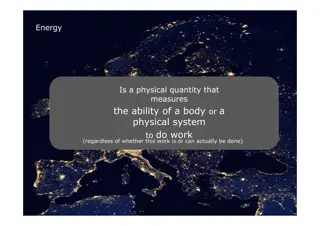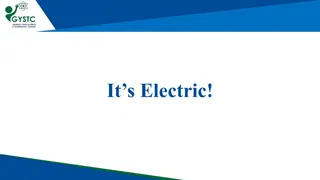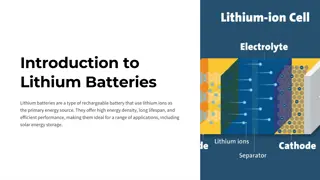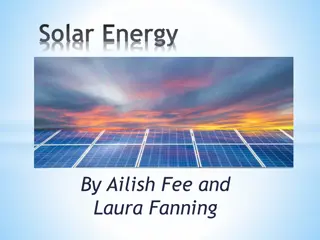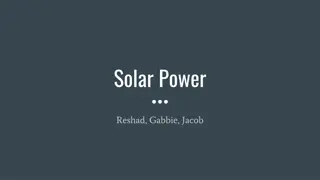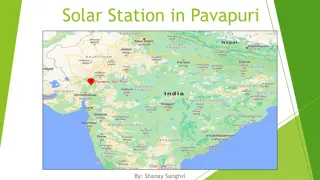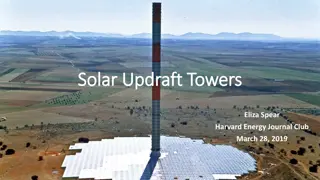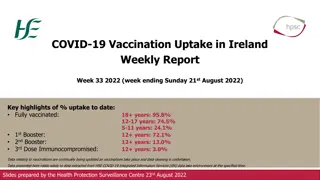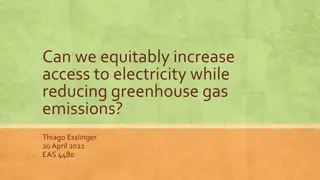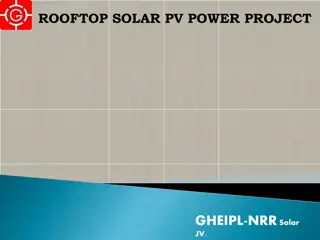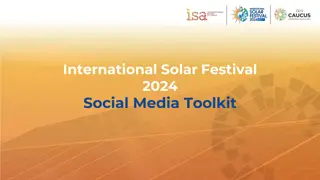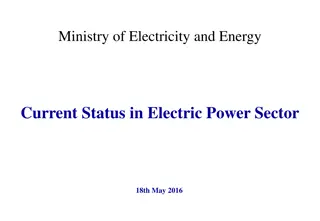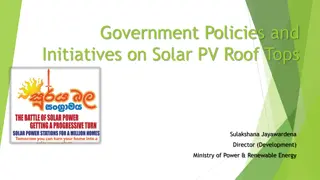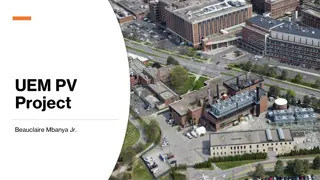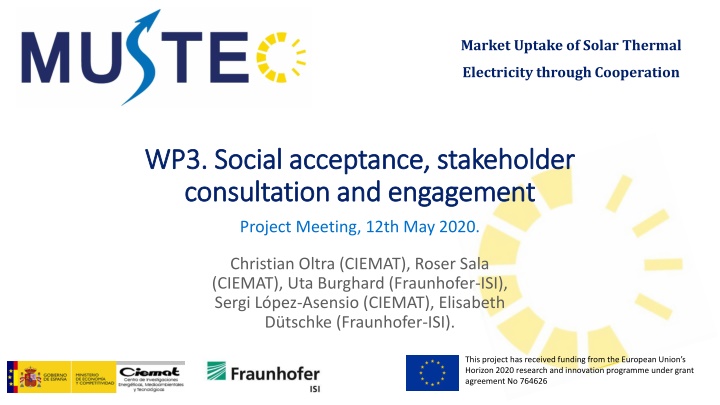
Market Uptake of Solar Thermal Electricity Cooperation Project
This project focuses on social acceptance and stakeholder engagement in the market uptake of solar thermal electricity through cooperation. It aims to understand public attitudes, perceived benefits, and risks of joint projects in Europe, with a strong emphasis on stakeholder consultation and surveying public acceptance levels.
Download Presentation

Please find below an Image/Link to download the presentation.
The content on the website is provided AS IS for your information and personal use only. It may not be sold, licensed, or shared on other websites without obtaining consent from the author. If you encounter any issues during the download, it is possible that the publisher has removed the file from their server.
You are allowed to download the files provided on this website for personal or commercial use, subject to the condition that they are used lawfully. All files are the property of their respective owners.
The content on the website is provided AS IS for your information and personal use only. It may not be sold, licensed, or shared on other websites without obtaining consent from the author.
E N D
Presentation Transcript
Market Uptake of Solar Thermal Electricity through Cooperation WP3. Social acceptance, stakeholder WP3. Social acceptance, stakeholder consultation and engagement consultation and engagement Project Meeting, 12th May 2020. Christian Oltra (CIEMAT), Roser Sala (CIEMAT), Uta Burghard (Fraunhofer-ISI), Sergi L pez-Asensio (CIEMAT), Elisabeth D tschke (Fraunhofer-ISI). This project has received funding from the European Union s Horizon 2020 research and innovation programme under grant agreement No 764626
Key research questions of WP3 What are the levels of societal acceptance of cooperation projects of the RES Directive to supply electricity from Concentrated Solar Power (CSP) plants in the South of Europe to Central and Northern Europe in potential hosting and off-taking countries? What are the perceived benefits and risks and the general attitude towards joint projects among the general public and key stakeholders (including policy makers, industry, science, opinion shapers at the local-regional, national, European)? 2
Tasks Task 3.1. Identification of relevant stakeholders Task 3.2. Stakeholder consultation Task 3.3. Survey of public acceptance Task 3.4. Stakeholder engagement exercise 2017 III 2018 I D3.1 (M6) 2019 I 2020 I II III II III II III Task 3.1 Task 3.2 D3.2 (M18) Task 3.3 D3.3 (M24) Task 3.4 D3.4 (M32) 3
Multi-country Survey study To estimate levels of public acceptance and support and related attitudinal dimensions (affect, norms, trust) regarding joint projects in selected potential host and off-taker countries. To identify key individual, attitudinal, socio-demographic and contextual determinants of public attitudes and acceptance of joint projects; To report on cross-country comparisons in public awareness, attitudes towards and acceptance of joint projects. 5
Multi-country Survey study Nationally representative online survey in four countries (host and off-taker) Questionnaire with provision of information Table. Characteristics of the sample (shares in %) Spain Germany The Romania Netherlands 51 49 19 16 20 26 20 64 36 800 Women Men 18-29 30-39 40-49 50-64 65 and older Non-university University N 51 49 17 21 20 22 21 45 55 800 48 52 16 14 20 25 25 78 22 802 51 49 20 19 18 25 18 41 59 800 6
Nero Renewables Solar S3 Nero Renewables plans to install 362 wind turbines at 3 different sites in South-East Romania and transfer the electricity generated to the onshore network and ultimately to consumers in The Netherlands The idea of Solar S3 is to build a solar power plant (see photo below) in South-West Spain and transfer the electricity generated to the onshore network and ultimately to German consumers 7
Questionnaire Introduction to the study Prior attitudes Information about cooperation mechanisms Awareness and personal relevance Information about a specific joint project Initial evaluation, affects and beliefs Information on consequences Global evaluation, acceptance and support 8
Results SPAIN GERMANY Closer cooperation in energy production in the European Union, resulting in greater dependence 11% 15% 7% Less cooperation in energy production in the European Union, resulting in less dependence on other states 1 15% 2 3 No opinion 70% 82% 9
Results Relatively high level of acceptance of Solar S3 in both countries (65-78%) Relatively high level of support for public investments in Solar S3 in both countries (around 60%) 10
Results Acceptance 60 Significantly higher levels of acceptance of the Project in Spain relative to Germany (dif. of 15%) 50 40 30 20 10 0 Totally unacceptable Unacceptable Neutral Acceptable Totally acceptable Spain Germany 11
Results Emotional reaction 45 More positive emotional reaction among Spanish respondents relative to German respondents 40 35 30 25 20 15 10 5 0 Aversion 2 3 4 Enthusiasm Spain Germany 12
Results Expected socio-economic impacts 60 Perceived as more beneficial (in terms of socio-economic impacts) among Spanish citizens relative to German cititzens 50 40 30 20 10 0 1- very negative impacts 2 3 4 5- very positive impacts Spain Germany 13
Evaluation of consequences excercise (Spanish participants) 14
Evaluation of consequences excercise (German participants) 15
Socio-demographic predictors of support Table. Support for public investment in the joint project by socio- demographics (as % of respondents, total sample) % of support Sex Women Men Age 18-29 30-39 40-49 50-64 > 65 Education Did not graduate from high school High school graduate Vocational education University 58% 63%* 59% 59% 58% 60% 66%* 43% 56% 57% 68%* 16 * the difference between categories is statistically significant, p<0.01
Supporters and sceptics 5 4.5 SUPPORTERS 4 3.5 SCEPTICS 3 2.5 2 1.5 1 Need to reduce CO2 emissions Need for an internal EU energy market Preference for coopeartion Belonging to EU Interest Impacts country (energy system) Socio-economic impacts Overall evaluation 17
Results: Predictors of support Figure. Path analysis with direct and indirect effects on support of public investments for a joint project of distinct variables (standardized coefficients) EMOTIONS AND BELIEFS PRIOR ATTITUDES Problem perception .18 Attachment (European) .33 .06 .32 .17 .27 Affect .47 Environmental self-image .07 Attitude Support .37 .30 .18 .18 Perceived benefits/costs .15 Preference for cooperation .24 .17 Perceived equity 18
Results: Predictors of support Table 7. Direct and indirect effects on support of public investments on a joint project of distinct variables (standardized coefficients ) Direct effect Indirect effect (one step) Indirect effect (two steps) Overall evaluation .47* Problem perception .03 Affect .13* Perceived benefits/costs .17* Perceived equity .08* Place attachment (EU) .12* Environmental self- image Preference for cooperation .07* .03* * sig. <0,05 19
Conclusion Medium to high levels of acceptance of joint projects in the four studied countries Significant differences in acceptance between participants in host and off-taker countries Perception of benefits and costs and emotions as main predictors of acceptance. Prior attitudes (attachment to European Union, environmental attitudes and preference for cooperation) are also relevant determinants 20
Task 3.4. Stakeholder engagement: Delphi study A Delphy study with European energy experts has been designed on the possible future of CSP cooperation in Europe. Specifically, they were consulted about how will cross-border cooperation agreements on renewable energies develop in the European Union in the medium term? 22
Data collection Multi-stage survey procedure with a group of energy experts to estimate future trends or developments. Online implementation with personal email invitation 2 rounds (December 2019-April 2020) Country N 1st N 2nd round round Spain 4 4 Germany 4 2 Other countries 3 3 Total 11 9 23
Explored dimensions Brief information about cooperation mechanisms. Assessment of Scenario 1: Dominant pathway: market-centred. Assessment of Scenario 2: Minority pathway: grassroots-centred. Cross-border cooperation agreements on renewable energy between European countries based on the RES Directive (type of scheme and type of technology). Perceived likelihood of a Joint project to co-fund a Concentrated Solar Power (CSP) plant. Recommendations to foster CSP cooperation projects. 24
Findings Scenario 1. Dominant pathway: market-centred Do you think this scenario accurately represents the currently dominant pathway in the EU? Thinking in very long term (20-40 years), how likely do you think is that it will become real? SCENARIO 1 SCENARIO 1 40% 100% - Certain 35% Around 93% - Almost certain 30% Around 75% - Probable 25% Around 50% - Chances about even 20% 15% Around 30% - Probably not 10% Around 7% - Almost certainly not 5% 0% - Impossible 0% 0% 5% 10% 15% 20% 25% 30% 35% 40% Not at all Neutral Yes completely
Findings Scenario 2. Minority pathway: grassroots-centred Do you think this scenario accurately represents the currently dominant pathway in the EU? Thinking in very long term (20-40 years), how likely do you think is that it will become real? SCENARIO 2 SCENARIO 2 50% 100% - Certain 45% Around 93% - Almost certain 40% 35% Around 75% - Probable 30% Around 50% - Chances about even 25% 20% Around 30% - Probably not 15% Around 7% - Almost certainly not 10% 0% - Impossible 5% 0% 0% 10% 20% 30% 40% 50% Not at all Neutral Yes completely
Findings Likelihood (%) of a joint project involving CSP trade from South (e.g. Extremadura, Spain) to Northern Europe (e.g. Germany) 2025-2030 2030-2040 60 80 70 50 60 Round 1 Round 2 40 Round 1 Round 2 50 30 40 30 20 20 10 10 0 0
Next steps Task 3.4. Stakeholder acceptance workshop (June-September, 2020) Germany: Webinar will take place on 24 June 2020, 13:00-14:30 (in German) Goal: identify drivers and barriers for CSP projects that can supply renewable electricity to countries, like Germany. Target group: representatives from industry, science, NGOs and policy makers Topics: Political framework conditions for RE cooperation projects in Europe: Introduction to the political background What opportunities and potentials do European cooperation projects have? Empirical studies on the social acceptance of CSP in Europe Open questions and discussion on drivers and barriers for European cooperation projects on renewable energies 28
Market Uptake of Solar Thermal Electricity through Cooperation Thank you! This project has received funding from the European Union s Horizon 2020 research and innovation programme under grant agreement No 764626


